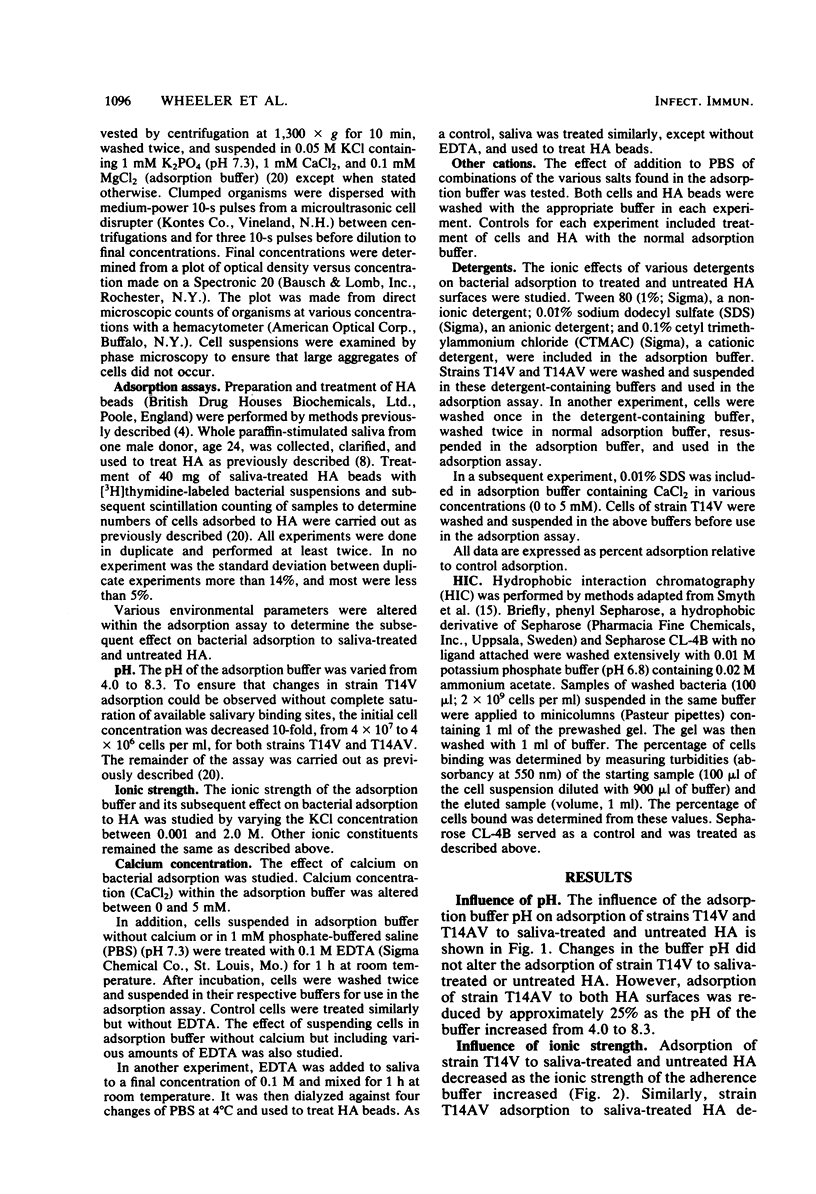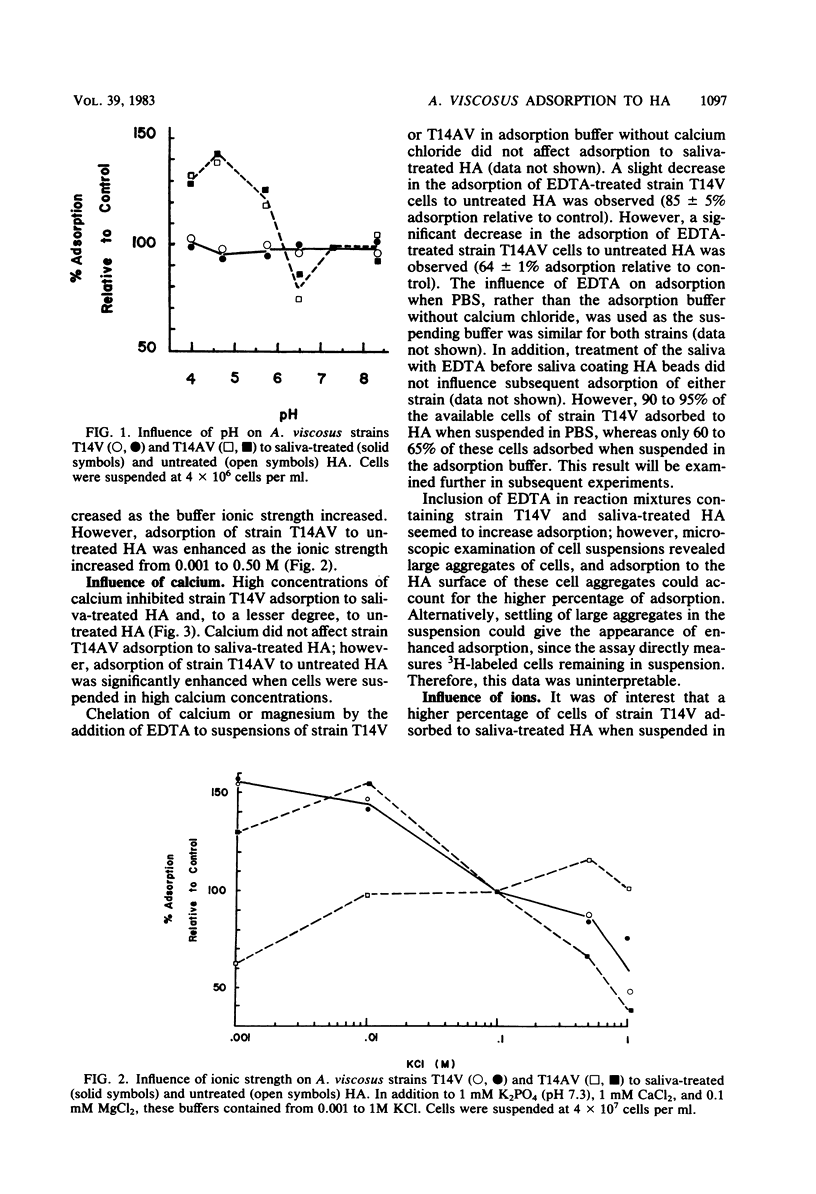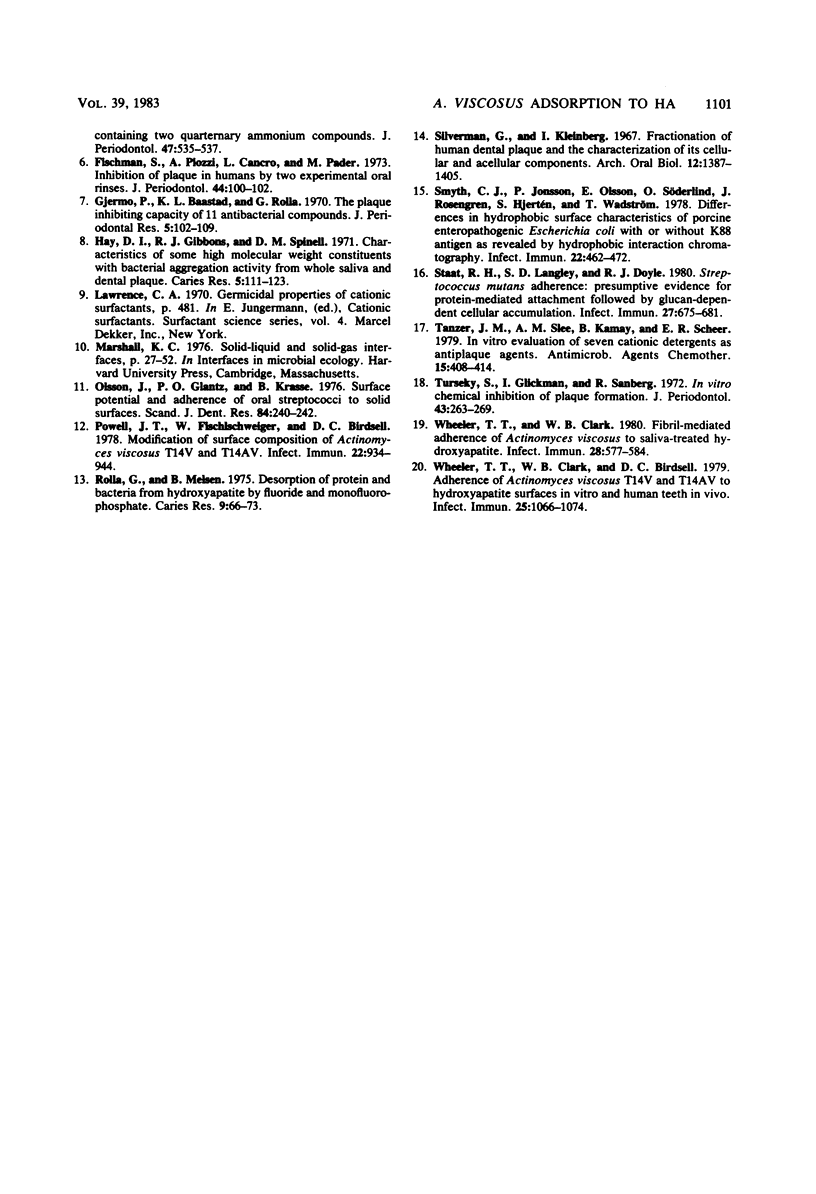Abstract
Adsorption of Actinomyces viscosus strains T14V and T14AV to saliva-treated and untreated hydroxyapatite (HA) under various environmental conditions was studied. Strain T14V adsorption to saliva-treated HA was not influenced by pH, whereas strain T14AV adsorbed in higher numbers under acidic conditions. The addition of cations inhibited adsorption of strains T14V and T14AV to saliva-treated HA. Strain T14V possessed a greater affinity for hydrophobic gels than did strain T14AV, but incorporation of non-ionic detergents, which inhibit hydrophobic interactions, did not influence adsorption of strain T14V to saliva-treated HA. Adsorption of strain T14V to saliva-treated HA increased in the presence of an anionic detergent; however, strain T14AV adsorption was not affected. Strain T14V adsorption decreased in the presence of a cationic detergent, whereas strain T14AV adsorption increased. Collectively, these data suggest that electrostatic interactions, but not hydrophobic interactions, are of major importance in the adsorption of strain T14V to saliva-treated HA.
Full text
PDF






Selected References
These references are in PubMed. This may not be the complete list of references from this article.
- Barnes G. P., Roberts D. W., Katz R. V., Woolridge E. D., Jr Effects of two cetylpyridinium chloride-containing mouthwashes on bacterial plaque. J Periodontol. 1976 Jul;47(7):419–422. doi: 10.1902/jop.1976.47.7.419. [DOI] [PubMed] [Google Scholar]
- Brecher S. M., van Houte J., Hammond B. F. Role of colonization in the virulence of Actinomyces viscosus strains T14-Vi and T14-Av. Infect Immun. 1978 Nov;22(2):603–614. doi: 10.1128/iai.22.2.603-614.1978. [DOI] [PMC free article] [PubMed] [Google Scholar]
- Clark W. B., Bammann L. L., Gibbons R. J. Comparative estimates of bacterial affinities and adsorption sites on hydroxyapatite surfaces. Infect Immun. 1978 Mar;19(3):846–853. doi: 10.1128/iai.19.3.846-853.1978. [DOI] [PMC free article] [PubMed] [Google Scholar]
- Fischman S. L., Picozzi A., Cancro L. P., Pader M. The inhibition of plaque in humans by two experimental oral rinses. J Periodontol. 1973 Feb;44(2):100–102. doi: 10.1902/jop.1973.44.2.100. [DOI] [PubMed] [Google Scholar]
- Gjermo P., Baastad K. L., Rölla G. The plaque=inhibiting capacity of 11 antibacterial compounds. J Periodontal Res. 1970;5(2):102–109. doi: 10.1111/j.1600-0765.1970.tb00700.x. [DOI] [PubMed] [Google Scholar]
- Hay D. I., Gibbons R. J., Spinell D. M. Characteristics of some high molecular weight constituents with bacterial aggregating activity from whole saliva and dental plaque. Caries Res. 1971;5(2):111–123. doi: 10.1159/000259739. [DOI] [PubMed] [Google Scholar]
- Olsson J., Glantz P. O., Krasse B. Surface potential and adherence of oral streptococci to solid surfaces. Scand J Dent Res. 1976 Jul;84(4):240–242. doi: 10.1111/j.1600-0722.1976.tb00486.x. [DOI] [PubMed] [Google Scholar]
- Powell J. T., Fischlschweiger W., Birdsell D. C. Modification of surface composition of Actinomyces viscosus T14V and T14AV. Infect Immun. 1978 Dec;22(3):934–944. doi: 10.1128/iai.22.3.934-944.1978. [DOI] [PMC free article] [PubMed] [Google Scholar]
- Rosa M., Sturzenberger O. P. Clinical reduction of gingivitis through the use of a mouthwash containing two quaternary ammonium compounds. J Periodontol. 1976 Sep;47(9):535–537. doi: 10.1902/jop.1976.47.9.535. [DOI] [PubMed] [Google Scholar]
- Rölla G., Melsen B. Desorption of protein and bacteria from hydroxyapatite by fluoride and monofluorophosphate. Caries Res. 1975;9(1):66–73. doi: 10.1159/000260144. [DOI] [PubMed] [Google Scholar]
- Silverman G., Kleinberg I. Fractionation of human dental plaque and the characterization of its cellular and acellular components. Arch Oral Biol. 1967 Dec;12(12):1387–1405. doi: 10.1016/0003-9969(67)90177-x. [DOI] [PubMed] [Google Scholar]
- Smyth C. J., Jonsson P., Olsson E., Soderlind O., Rosengren J., Hjertén S., Wadström T. Differences in hydrophobic surface characteristics of porcine enteropathogenic Escherichia coli with or without K88 antigen as revealed by hydrophobic interaction chromatography. Infect Immun. 1978 Nov;22(2):462–472. doi: 10.1128/iai.22.2.462-472.1978. [DOI] [PMC free article] [PubMed] [Google Scholar]
- Staat R. H., Langley S. D., Doyle R. J. Streptococcus mutans adherence: presumptive evidence for protein-mediated attachment followed by glucan-dependent cellular accumulation. Infect Immun. 1980 Feb;27(2):675–681. doi: 10.1128/iai.27.2.675-681.1980. [DOI] [PMC free article] [PubMed] [Google Scholar]
- Tanzer J. M., Slee A. M., Kamay B., Scheer E. R. In vitro evaluation of seven cationic detergents as antiplaque agents. Antimicrob Agents Chemother. 1979 Mar;15(3):408–414. doi: 10.1128/aac.15.3.408. [DOI] [PMC free article] [PubMed] [Google Scholar]
- Turesky S., Glickman I., Sandberg R. In vitro chemical inhibition of plaque formation. J Periodontol. 1972 May;43(5):263–269. doi: 10.1902/jop.1972.43.5.263. [DOI] [PubMed] [Google Scholar]
- Wheeler T. T., Clark W. B., Birdsell D. C. Adherence of Actinomyces viscosus T14V and T14AV to hydroxyapatite surfaces in vitro and human teeth in vivo. Infect Immun. 1979 Sep;25(3):1066–1074. doi: 10.1128/iai.25.3.1066-1074.1979. [DOI] [PMC free article] [PubMed] [Google Scholar]
- Wheeler T. T., Clark W. B. Fibril-mediated adherence of Actinomyces viscosus to saliva-treated hydroxyapatite. Infect Immun. 1980 May;28(2):577–584. doi: 10.1128/iai.28.2.577-584.1980. [DOI] [PMC free article] [PubMed] [Google Scholar]


